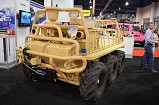 |
||
| > Reader's Photo OX5 by Lockheed Martin |
||
| • ADVERTISE WITH US | ||
| • WHO IS MOAB JEEPER? | ||
Home > Jeep Articles > General - Tools > Torque Wrenches -- Did you lose something? |
||||||||||||||||||||||||||||||
 |
||||||||||||||||||||||||||||||
|
Torque Wrenches -- Did you lose something?Article written by Moab ManDate Added: 09/12/2010 At some point if you turn wrenches, you will learn the importance of proper torque. The one example of the need for proper torque that will cause your friends the most laughter is when you tell them about how you lost a wheel while driving. |
My first experience with learning the value of a torque wrench came in 1986 when the rear wheel of my parents Pontiac Grand Prix passed me on the driver?s side of the car. |

|
|
Two educational things came from this experience. First, not every shade-tree mechanic learns the first time ? my father?s solution? Make the lugs even tighter. Second, when lug nuts share the load equally, they tend to not vibrate themselves loose.
While loosing a wheel is certainly one of the more dramatic examples, there are many other reasons for using proper torque. |

|
|
1. While not perceivable to your eye, when tightening down a bolt there is a stretching that occurs. A certain amount of stretch causes tension on the fastener. This is good. However, you know what they say about too much of a good thing? Over stretching the bolt will cause fatigue ysl replicas and eventual failure. A torque wrench, when used with a correct specification, keeps the bolt within operating range. 2. Sometimes a torque specification is meant to prevent damage to a component. For example, the torque load for the steel threaded spark plugs going into the aluminum head of the engine is usually around 15 ft lbs. Over-tightening of the spark plugs will eventually fatigue the aluminum threads and possibly strip them ? an expensive repair. 3. Seals! This is one that can cause a simple leak repair to turn into a cranium splitting nightmare. A seal is meant to have a specific compression. This allows the seal to (technical jargon coming up) properly squish and prevent a fluid or gas from getting past. Too little pressure and no squish. Too much pressure and the seal will crush.
4. Speaking of crush, aluminum is an interesting material. In some respects it can be incredibly strong, and yet it can be so brittle. Over-tightening aluminum with a steel bolt can cause it to break or crack. Anyone over-torque a transfercase bolt and break off a tab or even crack the case? Yup, it happens. | |
|
Hoping that we have impressed upon you the importance of torque wrenches, let?s transition to looking at a few types of torque wrenches. | |
|
Beam Style Torque Wrench ? This is your most basic of torque wrenches. Pulling of the handle causes a twist at the head which moves the indicator bar to show the torque load.
Summary ? Costs less. 0-75 ft lbs $24.99 Craftsman Beam Torque Wrench, 3 / 8 in. Drive / 0-150 ft lbs $29.99 Craftsman 150 ft lb Beam Style Torque Wrench 1/2 in. Drive. Takes a bit more user interaction as you have to watch the indicator. Upside, allows for really low torque readings. (09-12-2010) |

|
|
Traditional ?Click? Torque Wrench ? Costs more, but if you can swing it you?ll be happy you did. Set the torque, pull, and listen for the click. It doesn?t get much easier than that. Summary ? Cost is about 3x higher - 10-75 ft lbs $79.99 Craftsman Craftsman Microtork® Torque Wrench, 10-75 ft. lbs., 3 / 8 in. Drive / Craftsman Microtork® Torque Wrench, 20-150 ft. lbs., 1/2 in. Drive (09-12-2010). Downside: You will need a second torque wrench for smaller torque loads. > |

|
|
Inch Pound ?Click? Torque Wrench ? Many smaller torque specs are listed in inch pounds. For these smaller loads there are click style torque wrenches to cover those jobs below the range of more traditional 30-150 ft lbs torque wrenches. Summary ? Choose the one you need. 1/4 in. drive will cover really small torque loads while its bigger brother, the 3/8 in drive, will work for most of us shade tree mechanics. |

|
|
How To Use 1. Pull from the handle. Some wrenches will have specific marks indicating the pull area.
2. While applying torque keep your hand off the head of the wrench. |

|
|
3. Don?t bounce the load on your torque wrench. Pull in a smooth motion. 4. Once the wrench ?clicks?? STOP! I have personally witnessed people with a misguided belief that you should take it a 1/4 turn more. If you?re not going to listen to the torque wrench what is the point of using it.
5. When you are done using the torque wrench return it to its lowest setting for storage. |

|
|
6. Avoid using extensions. The longer the extension the greater the distortion in torque. Keep the torque wrench as close as possible to the fastener. There are calculators online that allow you to input length of the extension(s) used and what the torque wrench should be set at to compensate. |

|
|
7. Crows feet ? again, locate an online calculator for a corrected torque value. 8. Never take the torque wrench above or below the wrenches torque range. 9. Assume the torque wrench is right hand only unless indicated otherwise.
10. And the least popular? Read the instruction manual. Some wrenches need to be lubricated. |

|
|
| |
Final ThoughtsUsing proper torque is never appreciated until you screw something up. And with that thought in your head, in the next couple of weeks our very own Adventure Bob will demonstrate how to properly replace a pinion seal when he rebuilds the axle on our Grand Cherokee. | |
|



